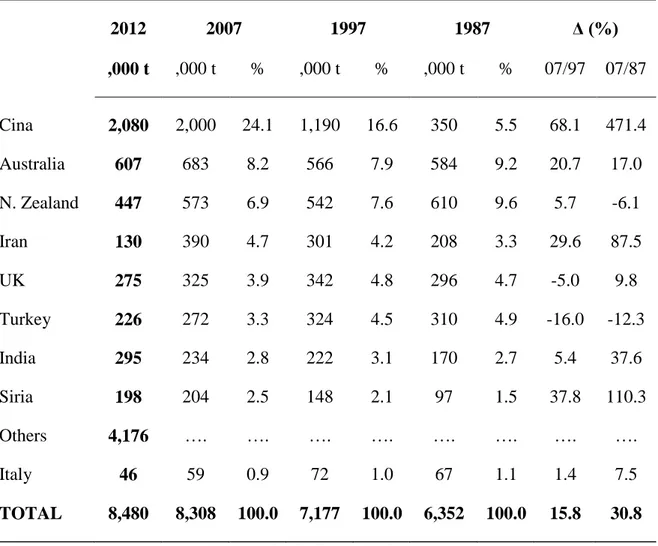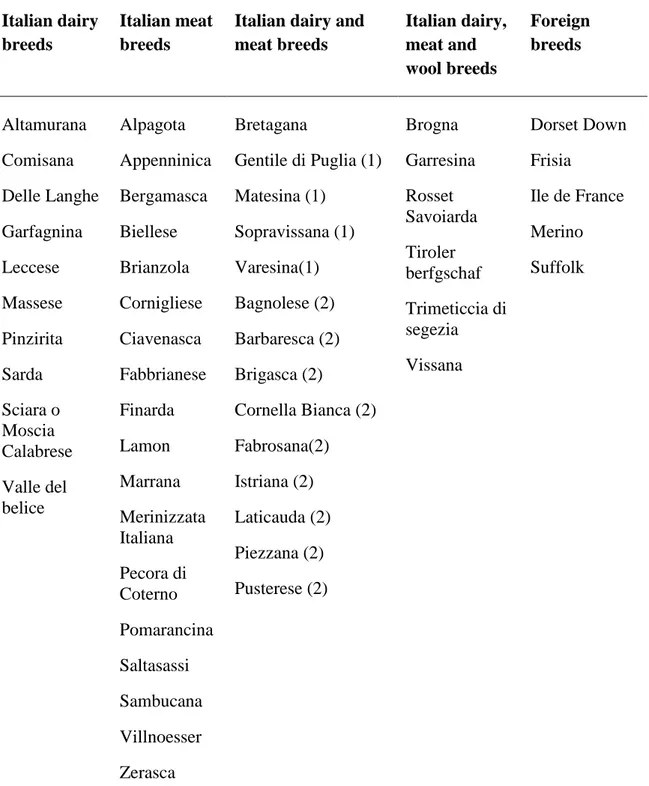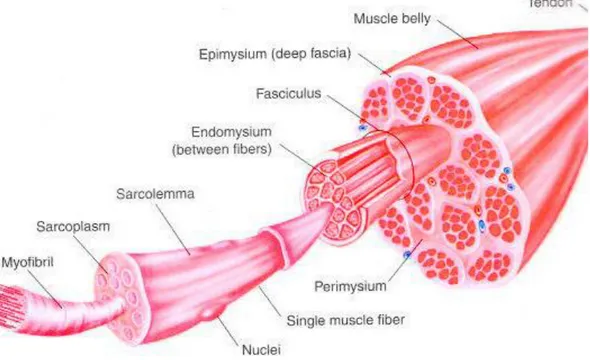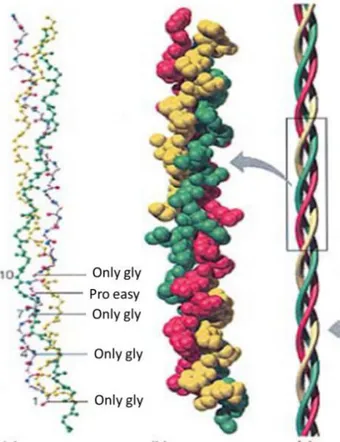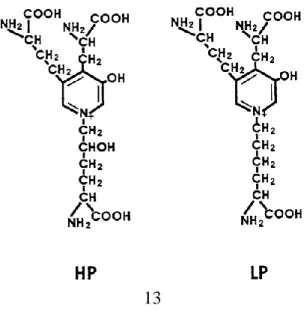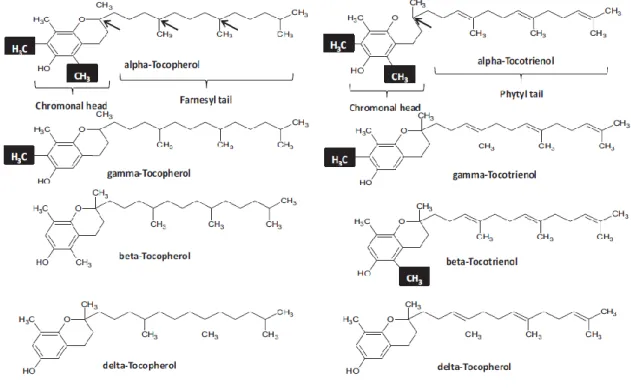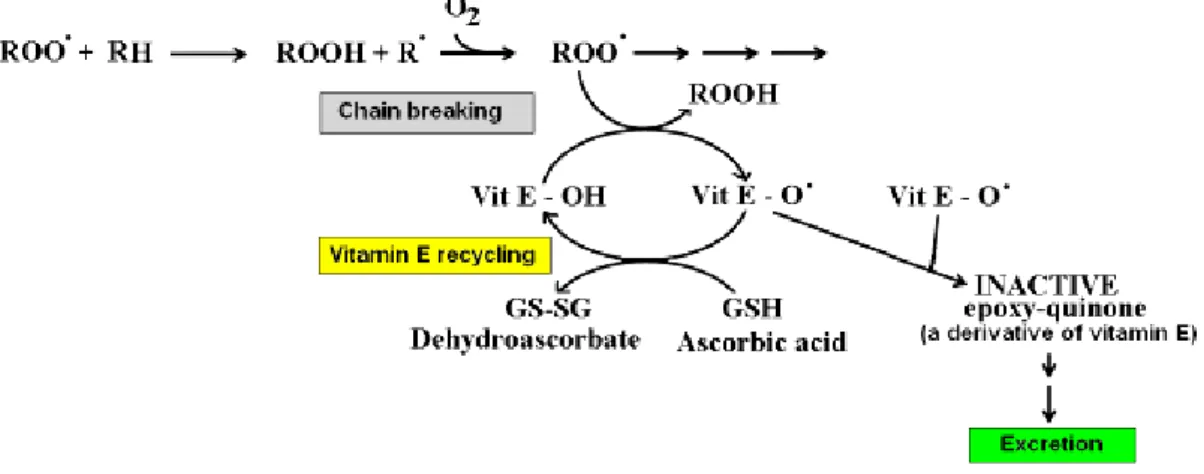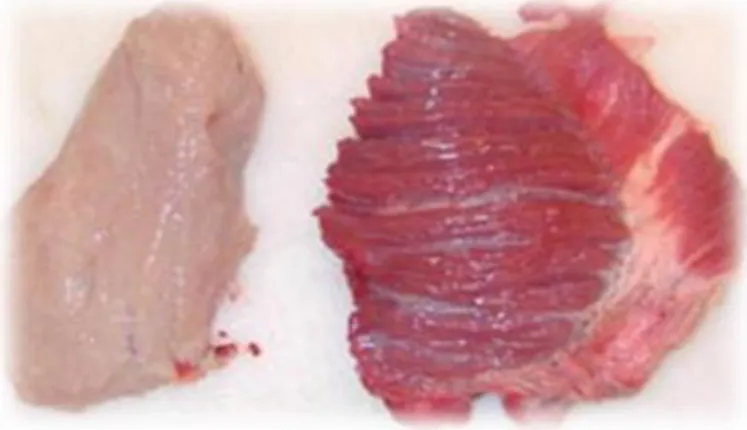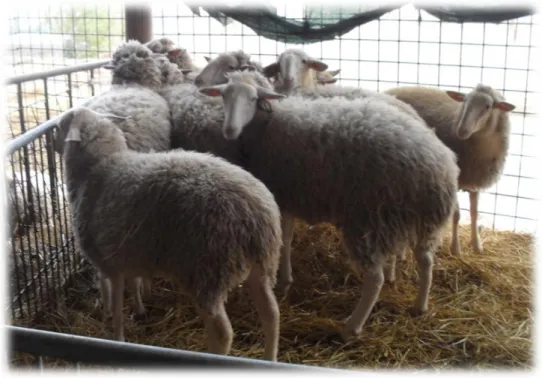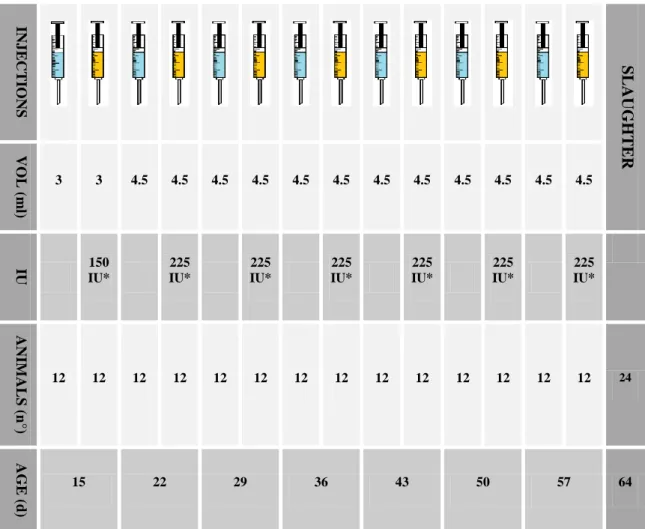U
NIVERSITY OF
M
OLISE
Department of Agricultural, Environmental and Food Sciences
INTERNATIONAL Ph.D. in
“WELFARE, BIOTECHNOLOGY AND QUALITY OF ANIMAL PRODUCTION” (XXVI CYCLE)
Related disciplinary scientific section: 07/G1 (Scienze e Tecnologie Animali)
General Coordinator: Prof. Giuseppe Maiorano
Doctorate Thesis Title:
Influence of multiple injections of vitamin E
on quality traits and oxidative stability
of lamb meat
Ph.D. Candidate:
Dr. Domenico Di Memmo
143440
Supervisors:
Prof. Mario Gambacorta
Prof. Giuseppe Maiorano
Acknowledgments
I would like to thank my co-supervisor, professor Giuseppe Maiorano, and my supervisor, professor Mario Gambacorta, for their invaluable inputs towards the completion of this work. Working with You was a big privilege and an unique opportunity to improve my knowledge. I would also like to thank the University of Molise.
Secondly, my heartfelt gratitude goes to all the people that I met during the International PhD study, and to all my collegues in “Welfare, Biotechnology and Quality of Animal Production”, in particular to Ms. Abiuso Cinzia, Ms. Cianciullo Daniela, Mr. Di Iorio Michele, Mr. Gentile Andrea, Ms. Mucci Rossella, Ms. Nardoia Maria, Ms. Rocco Martina, Ms. Tavaniello Siria, Ms. Wilkanowska Ania, Mr Vizzarri Francesco. Thank’s for their overwhelming support.
I extend my thanks also to my Polish tutor professor Marek Bednarczyk and to all my Polish colleagues.
A big thank you goes to my family, to my friends who have encouraged me through the course of the work. To the farmers that I met during this period I extend my sincere gratitude for your invaluable input without which this work would not have been completed. Thank you so much and keep up the good work.
To all those whose I have not mentioned the name and who, in one way or another, contributed to the success of this work, I want to give my sincere thanks.
I
Abstract
Transporting animals to the slaughterhouse can increase the susceptibility of meat quality and, therefore, influence the value of pH, TBARS and the oxidation of fatty acids and pigments. Lipid oxidation cause negative changes on structure and nutrition value such as meat flavour, odour and colour: it is well know that colour is the characteristic that more affects the decision of the consumer to purchase. For this reason a supply of antioxidants is recommended to preserve the health of animals and the oxidative stability of their products. One of the most widely used antioxidants in animal diet is vitamin E. It is a lipid soluble and chain breaking antioxidant that protect cellular membranes against oxidative damages. The most active and natural form of vitamin E is
-tocopherol. It is now accepted that dietary supplementation with -tocopheryl acetate controls lipid oxidation and colour deterioration in red meat like lambs and beef. In literature has been reported that intramuscular injections of tocopherols had a quite similar effect to the supplementation of vitamin E in diet. However, controversial information regarding the productive performances are also showed in some works on lambs. No information exists in literature on performance and meat quality traits of Laticauda lambs injected with Vitamin E. Laticauda is an autochthonous breed of Campania Region in Italy, that is usually reared by small family farms under semi-extensive systems. It derives from crossbreeding local sheep from the Appennines breed with fat-tailed North African sheep, imported in the XVIII century. Laticauda breed has a prevailing attitude toward meat production, associated to a good prolificacy.
In the light of the above mentioned, the aim of the study was to determine the effect of DL-α-tocopheryl acetate injections on carcass and meat quality traits in growing lambs. Twenty-four 15-d-old Laticauda male lambs were randomly allotted to two groups: control (C, n =12) or vitamin E-treated (V, n=12). From the beginning of the study (15 days of age) until day 57 of age, each lamb of the V group received, weekely, i.m. injections of DL-α-tocopheryl acetate (right gluteus) in aqueous solution (Vitalene® E, Fatro, Bologna) for seven weeks for a total dose of 1,500 IU. The first injection consisted of 150 UI (3ml of Vitalene), while the other 6 injections consisted of 225 IU (4.5 ml of Vitalene). C group lambs received injections of physiological saline.
II
The animals were slaughtered at 64d of age. Hot and cold carcass weights were recorded and dressing percentages were calculated after dressing and chilling (2–4 °C for 24 h). After chilling, pH, colour, area, water holding capacity of M. longissimus dorsi (LD) were measured and shrink losses were calculated. After the refrigeration period (24 h at 2-4 °C), from the left side of the carcass the pelvic limb, loin and shoulder were removed and theirs percentage was calculated based on cold carcass weight. Vastus lateralis (VL) and longissimus dorsi (LD) muscles were removed for laboratory analyses (LD: fatty acids, cholesterol, intramuscular collagen, crosslinks; LD and VL: α-tocopherol content). For the same muscles TBARS (µg MDA/g tissue) at 24, 48, 96 and 192 h post mortem were measured during aerobic display at 5°C. Sensory analysis was performed on the pelvic limb from the left side of each lamb carcass, having two panels: one for the students, and the other one for customary consumers of lamb meat. Each panellist was required to evaluate the sample considering the intrinsic characteristics of the meat – tenderness, juiciness, flavour and overall acceptability (general pleasantness) – according to an unstructured line scale ranging from 1 (―very unpleasant‖) to 9 (―very pleasant‖).
Vitamin E administration did not influence significantly live weight, carcass traits, except the incidence of pelvic limb, significantly higher in V group lambs; LD quality traits did not differ between the experimental groups, except for the red colour value (a*) that was higher (P<0.05) in lambs of vitamin E group.
Treatment with vitamin E did not significantly affect the total SFA content and the proportion of single SFA, except for a slightly higher (P < 0.08) content of lauric acid (C 12:0) and lower (P < 0.01) content of eptadecanoic acid (C 17:0) in V group. Likewise, vitamin E treatment did not affect the total MUFA amount, except for a lower (P < 0.01) content of C 17:1 and higher C 18:1 n-9 trans (P < 0.05) and C 22:1 (P < 0.01) in V group. The oleic acid (C18:1 n-9 cis) was the most concentrated fatty acids (40-41%), followed by palmitic (20-21%) and stearic acids (14-15%). Vitamin E treatment positively affected the total PUFA content being higher (P < 0.01) in the V group compared with the control group. The vitamin E treated group had a significant higher amount of n-3 long chain PUFA: eicosapentaenoic fatty acid (EPA, C20:5n-3, P < 0.05), docosapentaenoic fatty acid (DPA, C22:5n-3, P < 0.01) and docosahexaenoic fatty acid (DHA, C22:6n-3, P < 0.06). Also vitamin E group had higher (P < 0.01) content of C 22:2. In light of this, the total n-3 FA content was higher (P < 0.01) in
III
treated lambs compared with the control group; while, no significant differences were found for the total n-6 FA amount. The n-6/n-3 ratio was lower in treated lambs (P < 0.01). The P/S ratio was higher (P < 0.01) in treated lambs. Trombogenic index was affected by the treatment being lower (P < 0.01) in vitamin E group.
Cholesterol content was found to be not significant (P > 0.05) between groups (78.78 versus 79.01 mg/100g in C and V, respectively).
Collagen characteristics were not significantly (P > 0.05) influenced by the treatment.
The treatment with vitamin E markedly increase (P < 0.001) the content of DL-α-tocopherol in both muscles (longissimus dorsi: 0.92 versus 6.41 µg/g in C and V, respectively; vastus lateralis: 0.99 versus 7.31 µg/g in C and V, respectively) and increases the meat shelf life. This was evident since muscle tissue lipoperoxidation levels (TBARS) were significantly lower (P<0.01) in vitamin E injected lamb meat (longissimus dorsi and vastus lateralis muscles) at 24, 48, 96 and 192 h post mortem, during all the aerobic display at 5°C.
The panel test showed that both the adult and the student judges, enjoyed both types of meat, giving a slightly higher point for the lamb that was injected with vitamin E if compared to the other type of meat (7.24 versus 6.97 respectively; P > 0.05). Therefore, both expressed a greater pleasure with the meat produced from lamb injected with vitamin E if compared to the meat of control group, as regard the descriptor of tenderness (6.66 versus 5.70, respectively; P< 0.05) and juiciness (6.39 versus 5.00; P < 0.05).
At the light of the above, the conclusion of this study is that the intramuscular administration of vitamin E can be recommended to obtain meat with a higher nutritional and commercial value.
IV
Riassunto
Il trasporto degli animali prima della macellazione, ed altri fattori di stress, possono influenzare le caratteristiche chimico-fisiche delle carni, e di conseguenza i valori di pH, TBARS e l‘ossidazione di acidi grassi e pigmenti. Questo processo causa peggioramenti qualitativi sia dal punto di vista nutrizionale che commerciale, soprattutto per quanto concerne l‘aroma e il colore delle carni, fattori che influenzano enormemente le scelte di acquisto del consumatore. Per questo motivo viene spesso raccomandata una integrazione di antiossidanti tramite la dieta per mantenere gli animali in buona salute e stabilizzare i prodotti dal punto di vista ossidativo. L‘antiossidante più utilizzato nelle produzioni animali è senz‘altro la Vitamina E. E‘ un composto liposolubile che ha la funzione principale di proteggere le membrane cellulari dai danni dell‘ossidazione. La forma biologicamente più attiva e più presente in natura è l‘-tocoferolo. È ad oggi universalente riconosciuto che una integrazione delle razioni alimentari con -tocoferil acetato stabilizza e controlla l‘ossidazione dei lipidi e il decadimento del colore, nelle carni rosse di specie ovine e bovine. Esiste anche una altra modalità di somministrazione della Vitamina E, ossia attraverso iniezioni intramuscolari di DL--tocoferil acetato. Questa modalità ha dimostrato di produrre effetti simili alla somministrazione attraverso la dieta, con risultati però spesso contraddittori, soprattutto per quanto riguarda le performance in vivo. Ad oggi non esistono studi di letteratura che descrivono l‘effetto di iniezioni intramuscolari di Vitamina E, sulle performance produttive e sulla qualità della carne di agnelli di razza Laticauda. Questa è una razza autoctona della regione Campania, spesso allevata in piccoli gruppi e con sistema di allevamento semi-estensivo. Deriva da incroci di ovini locali degli Appennini con pecore nord africane dalla coda grassa, importate in Italia nel XVIII secolo. E‘ una razza da carne, che presenta una buona prolificità.
Lo scopo del presente lavoro di tesi è stato quello di determinare l‘effetto di iniezioni multiple di Vitamina E (DL-α-tocoferil acetato) sulle performance produttive, sulla qualità e sulla stabilità ossidativa della carne di agnello.
Per la sperimentazione sono stati utilizzati 24 agnelli maschi, di razza Laticauda, di 15 giorni di età. Sono stati suddivisi in due gruppi, somministrando ad ogni animale,
V
settimanalmente, una soluzione fisiologica (Controllo: n=12) oppure DL-α-tocoferil acetato (Vitamina E: n=12; 1500 UI) fino all‘età di 57 giorni.
Gli animali sono stati macellati a 64 giorni. Il peso a caldo e a freddo è stato registrato e sono state calcolate le rispettive rese, dopo 24 ore di refrigerazione (2–4 °C). E‘ stato misurato il pH, il colore, l‘area e la capacità di ritenzione idrica (water holding capacity, WHC) del muscolo longissimus dorsi, e le perdite per gocciolamento delle carcasse. Dalla mezzena sinistra, sono stati rimosi i tagli della spalla, della coscia e del lombo e calcolate le relative incidenze sul peso a freddo. Successivamente, sono stati rimossi i muscoli vastus lateralis (VL) e longissimus dorsi (LD) dalla mezzena destra per le analisi di laboratorio. Sul LD è stata misurato il profilo degli acidi grassi, il contenuto di colesterolo, il contenuto di collagene intramuscolare e legami crociati (Idrossilisilpiridinolina, HLP); su LD e VL è stato quantificato il contenuto di α-tocoferolo (µg/g). Sugli gli stessi muscoli, sono stati determinati i TBARS (specie reattive all‘acido tiobarbiturico, µg MDA/g tessuto muscolare) a 24, 48, 96 e 192 ore post mortem in conservazione aerobica a 5°C.
L‘analisi sensoriale è stata effettuata sul coscio sinistro di ogni animale, utilizzando due panel: uno composto da studenti, l‘altro da consumatori abituali di carne di agnello. A ciascun panel è stato chiesto di valutare le caratteristiche intriseche della carne – tenerezza, succosità, sapore e accettabilità generale. I risultati sono stati espressi dai giudici tramite schede di valutazione con scala da 1 (molto sgradevole) a 9 (molto gradevole).
La somministrazione di Vitamina E non ha avuto effetti significativamente rilevanti sulle performance in vivo e post mortem, ad eccezione dell‘incidenza del coscio che è risultata maggiore (P>0.05) negli agnelli del gruppo di trattamento. Il pH, la WHC, l‘area del muscolo longissimus dorsi e il colore non sono risultati significativamente diversi tra i gruppi, ad eccezione dell‘indice del rosso (a*) che ha fatto registrare valori più elevati (P<0.05) negli agnelli trattamenti.
Il trattamento con vitamina non ha avuto effetti significativamente rilevanti sul contenuto totale degli acidi grassi saturi (SFA), fatta eccezione per una quantità lievemente più elevata di acido laurico (C 12:0) ed inferiore (P < 0.01) di acido eptadecanoico (C 17:0) nel gruppo vitamina. Lo stesso risultato è stato riscontrato per gli acidi grassi monoinstraturi (MUFA), fatta eccezione per il contenuto più basso (P < 0.01) di C 17:1 e più alto di C 18:1 n-9 trans (P < 0.05) e C 22:1 (P < 0.01) nel gruppo
VI
della vitamina E. L‘acido oleico (C18:1 n-9 cis) è risultato quello con la concentrazione più elevata (40-41%), seguito dal palmitico (20-21%) e dallo stearico (14-15%). Un effetto significativamente positivo (P < 0.01) è stato riscontrato sul contenuto totale di acidi grassi polinstaturi (PUFA), più elevati nel gruppo della vitamina E. Il più abbondante PUFA è risultato essere l‘acido linoleico (C 18:2 n-6), con valori simili trai gruppi (7.95 e 8.07%, in C e V rispettivamente). Il secondo più rappresentativo è l‘acido linolenico (C 18:3 n-3), che è contenuto principalmente nelle essenze verdi. Significativamente maggiore è risultato essere il contenuto di PUFA a lunga catena n-3 nel gruppo vitamina E: acido eicosapentanoico (EPA, C20:5 n-3, P < 0.05), docosapentaenoico (DPA, C22:5 n-3, P < 0.01) e docosaesaenoico (DHA, C22:6 n-3, P < 0.06). Anche il C 22:2 è risultato significativamente più alto (P < 0.01). Alla luce di ciò, il contenuto totale di n-3 è risultato maggiore (P < 0.01) negli agnelli trattati rispetto al controllo; mentre non sono state riscontrate differenze significativamente rilevanti per quanto concerne il contenuto totale di n-6. Il rapporto n-6/n-3 è risultato inferiore negli agnelli trattati (2.33 versus 3.62 in V e C, rispettivamente; P < 0.01). Il rapporto P/S invece è superiore (P < 0.01) negli agnelli trattati, anche se il valore ottenuto risulta inferiore a quello raccomandato (0.4-0.7). Anche l‘indice trombogenico (TI) è stato influenzato dal trattamento, ed è risultato inferiore (P < 0.01) nel gruppo vitamina.
Il contenuto di colesterolo non è risultato diverso (P > 0.05) tra i gruppi (78.78 versus 79.01 mg/100g in C e V, rspettivamente), ma leggermente più elevato se paragonato con altri studi su altre razze.
La concentrazione di collagene (22.59 e 22.57 μg/mg in C e V, rispettivamente) e di HLP (4.37 e 4.59 μg HLP/mg in C e V, rispettivamente), come anche la stabilità delle fibre di collagene (0.135 e 0.142 mol HLP/mol di collagene in C e V, rispettivamente) non sono state influenzate (P > 0.05).
Al contrario il trattamento con la vitamina E ha notevolmente incrementato (P < 0.001) il contenuto di DL-α-tocoferolo in entrambi i muscoli (longissimus dorsi: 0.92 versus 6.41 µg/g in C e V, rispettivamente; vastus lateralis: 0.99 versus 7.31 µg/g in C e V, rispettivamente) e ha incrementato la conservabilità della carne. Questo è risultato evidente dal momento che i livelli di TBARS sono stati significativamente più bassi (P < 0.01) negli agnelli trattati con vitamina E (longissimus dorsi and vastus lateralis muscles) a 24, 48, 96 e 192 h di conservazione aerobica a 5°C.
VII
Il panel test ha mostrato che sia gli adulti che gli studenti hanno gradito entrambi i tipi di carne, pur preferendo leggermente di più la carne degli agnelli trattati con vitamina E (piacevolezza generale: 7.24 e 6.97 rispettivamente; P > 0.05). Sia gli studenti che gli adulti hanno espresso un maggior gradimento per la carne del gruppo sperimentale per quanto riguarda i descrittori della tenerezza (6.66 versus 5.70, rispettivamente; P < 0.05) e succulenza (6.39 versus 5.00; P <0.05).
Alla luce dei risultati ottenuti, si può concludere che l‘utilizzo di Vitamina E per via intramuscolare, in agnelli di razza Laticauda, è consigliabile per ottenere carni con un più elevato valore nutrizionale e commerciale.
VIII
CONTENTS
Abstract (English) I
Riassunto (Italiano) IV
PART 1. INTRODUCTION (Literature review) pag.1 Chapter 1. Ovine production pag.1
1.1 Introduction pag.1
1.2 The importance of sheep sector in Italy pag.4
1.2.1 Italian meat breeds pag.7
Chapter 2. Attributes of lamb meat quality pag.8
2.1 Introduction pag.8
2.2 Chemical composition and nutritional aspect of lamb meat pag.9
2.2.1 Proteins pag.9
2.2.1.1 Collagen pag.10
2.2.2 Lipids pag.14
2.2.2.1 Fatty acids pag.15
2.2.2.2 Cholesterol pag.20
2.2.3 Vitamin and mineral content pag.21 2.3 Technological properties of meat pag.22
2.3.1 Water Holding Capacity pag.22
2.3.2 pH pag.24
2.4 Sensory aspects of meat pag.26
2.4.1 Colour of meat pag.26
2.4.2 Meat palatability pag.29
2.5 Classification of lamb carcasses pag.33
Chapter 3. Shelf life of lamb meat pag.37 3.1 Understanding and estimating the shelf-life of meat pag.37 3.2 Antioxidants and their effect on shelf-life of lamb meat pag.41 3.3 The thiobarbituric acid reacting substances (TBARS) pag.45
Chapter 4. Vitamin E pag.47
4.1 Introduction pag.47
4.2 Functions pag.49
4.2.1 Antioxidant functions pag.49
4.2.2 Non-antioxidant functions pag.51
4.3 Metabolism pag.52
4.3.1 Digestion and absorption pag.52
IX
4.3.3 Storage pag.53
4.4 Catabolism and excretion pag.53 4.5 Use of vitamin E to improve lamb meat quality pag.53
PART 2.AIM OF DISSERTATION pag.61
PART 3.
Chapter 5. MATERIALS AND METHODS pag.61 5.1 Description of Laticauda breed pag.61
5.2 Animals pag.64
5.2.1 Experimental design, slaughtering procedures, muscle
sampling, in vivo and post mortem measurement pag.64
5.2.2 Slaughter surveys pag.66
5.3 Meat analyses pag.67
5.3.1 Physico-chemical charachteristics pag.67 5.3.2 Preparation and storage of longissimus dorsi and vastus
lateralis muscles for the measurement of oxidative stability pag.68 5.3.3 TBARS (Thiobarbituric acid reactive substances) pag.69
5.3.4 Collagen analysis pag.69
5.3.4.1 Intramuscular collagen pag.70
5.3.4.2 Crosslink analysis pag.70
5.3.5 Cholesterol analysis pag.71
5.3.6 Fatty acid analysis pag.71
5.3.7 Alpha tocopherol content pag.72
5.4 Consumer panel pag.73
5.4.1 Quality-quantity test (blind test) pag.73 5.5 Statistical analysis pag.78
Chapter 6. RESULTS AND DISCUSSION pag.79 6.1 In vivo and post mortem performances pag.79 6.2 Physical and chemical properties pag.82
6.2.1 Physical properties pag.82
6.2.2 Fatty acids composition and cholesterol content pag.83 6.2.3 Intramusular collagen properties pag.89
6.2.4 Alpha tocopherol content pag.90
6.3 TBARS: oxidative stability pag.93
6.4 Panel test pag.98
Chapter 7. CONCLUSION pag.103
REFERENCES pag.105
X List of figures
Figure 2.1. Gross composition of muscle indicating epimysium,
perimysium and endomysium pag.11
Figure 2.2. Collagen molecule and its organization pag.12 Figure 2.3. Pyridinium crosslinks. Hydroxylysylpyridinoline (HP) and its
dehydroxy analog lysylpyridinoline (LP) pag.13
Figure 3.1. Mechanism of lipid oxidation pag.40 Figure 4.1. Vitamin E isoforms pag.47
Figure 4.2. Inhibition of lipid peroxidation chain reaction by Vitamin E and
mechanisms of recycling pag.50
Figure 4.3. White muscle disease vs normal muscle in lamb pag.60 Figure 5.1. Young Laticauda Sheeps in Casalbore, Southern Italy pag.63 Figure 5.2. Laticauda lambs in Casalbore, Southern Italy pag.63 Figure 5.3. Schema of the treatments (injections) pag.65 Figure 5.4. Example of carcass and left-side pelvic limb pag.68 Figure 5.5. Vastus lateralis muscles (control and treated group) preparation
for storage pag.68
Figure 5.6. Homogenization, filtration and coloration for TBARS analysis pag.69 Figure 5.7. The panel at the ―agriturismo Cassetta‖ pag.73 Figure 5.8. Information form pag.75 Figure 5.9. Professor Maiorano as Panel Leader pag.76 Figure 5.10a. Panel form, lamb meat pag.77 Figure 5.10b. Panel form, lamb meat pag.77 Figure 6.1. Content of α-tocopherol (µg/g) in longissimus dorsi (n=12)
and vastus lateralis (n=12) muscles between treatments (a) and within
treatment (b) (mean±SE) pag.92
Figure 6.2. TBARS (mg MDA/kg, meansSE) in longissimus dorsi muscle, within lambs treated (VG) and no treated, (CG) during
the aerobic storage period at 5°C pag.96
Figure 6.3. TBARS (mg MDA/kg, meansSE) in vastus lateralis muscle, within lambs treated (VG) and no treated (CG), during
the aerobic storage period at 5°C pag.96
Figure 6.4. Cuvette of Vitamin E group (left side) and Control group (right side) during the spectrophotometer reading (96h). It is possible to observe the different
coloration pag.97
Figure 6.5. Sensory analysis (rated on scale 1-9) of meat lambs (Vitamin E versus Control) perceived by judges (adults and students, mean±SE) pag.99 Figure 6.6. Level of general approval of lamb meat, obtained by vitamin E
treated (V) and control (C) lambs, perceived by the judges (adults versus
XI
Figure 6.7. Level of tenderness of lamb meat, obtained by vitamin E treated (V) and control (C) animals, perceived by the judges
(adults versus students, mean ± SE) pag.101 Figure 6.8. Level of flavour of lamb meat, obtained by vitamin E treated (V)
and control (C) animals, perceived by the judges
(adults versus students, mean ± SE) pag.101 Figure 6.9. Level of juiciness of lamb meat, obtained by vitamin E treated (V)
and control (C) animals, perceived by the judges
XII List of tables
Table 1.1. Number of sheeps per contry in 2013 (milions) pag.1 Table 1.2. Sheep meat productions by country (tons) pag.3 Table 1.3. Number of sheep in Italy by regions (Istat, 2011) pag.4 Table 1.4. Main sheep breeds in Italy pag.5 Table 2.1. Different methods of drip loss measurements and water holding
capacity of meat pag.24
Table 2.2. Fat thickness and USDA yield grades for lambs pag.34 Table 3.1. Antioxidant micronutrients pag.42 Table 5.1. Chemical composition of concentrate fed to lambs pag.66 Table 6.1. In vivo and slaughter performances (mean SE) pag.81 Table 6.2. pH, colour, WHC and area of longissimus dorsi (mean SE) pag.83 Table 6.3. Fatty acids composition (% of total fatty acids) and cholesterol
of longissimus dorsi (mean ± SE) pag.88
Table 6.4.Intramuscular collagen (IMC) properties of longissimus dorsi
(mean SE) pag.90
Table 6.5. Effect of the treatment (controll versus vitamin E) on the evolution of TBARS (mg MDA/kg, meansSE) in longissimus dorsi muscles during the
aerobic storage period at 5°C pag.95
Table 6.6. Effect of the treatment (controll versus vitamin E) on the evolution of TBARS (mg MDA/kg, meansSE) in vastus lateralis muscles during the
XIII
List of abbreviations
AA arachidonic acid
ACAT cholesterol acyltransferase ADF acid detergent fiber
AI atherogenic index Ala alanine
AOA antioxidant activity AP active packaging Arg arginine
ASI american sheep industries Asp aspartic acid
ASPA Association for Animal Science and Productions AV Avellino (City)
BHA butylated hydroxyanisole BHT butylated hydroxytoluene BW body weight
C control CAT catalase CG control group
CHAOS Cambridge heart antioxidant study CLA conjugated linoleic acid
CTGF connective tissue growth factor Cys cysteine
DFD dark firm and dry
DHA docosahexaenoic fatty acid DM dry matter
DPA docosapentaenoic fatty acid EBW empty bodyweight
EPA eicosapentaenoic fatty acid FA fatty acid
FAO Food and Agriculture Organization of the United Nations GC gas chromatography
GLM general linear model Glu glutamic acid
Gly glycine
GM gluteus medius
GPX glutathione peroxidase HDL high density lipoprotein HFBA n-heptafluorobutyric acid HHP high hydrostatic pressure His histidine
HLP hydroxylysylpyridinoline
HPLC high-performance (high-pressure) liquid chromatography Ile isoleucine
IMCT intramuscular connective tissue IR infrared
XIV LD longissimus dorsi
LDL low density lipoprotein Leu leucine
LL longissimus lumborum Lys lysine
MAP modified atmosphere packaging MDA malondialdehyde
Met methionine
MRP Maillard reaction products MT mile tonns
MUFA monounsaturated fatty acid
NADH nicotinamide adenine dinucleotide NDF neutral detergent fiber
P:S ratio of PUFA/SFA Phe phenylalanine PKC protein kinase Pro proline
PUFA polyunsaturated fatty acids RNS reactive nitrogen species ROS reactive oxygen species SE standard error
Ser serine
SFA saturated fatty acid SOD superoxide dismutase
SPSS Statistical Package for Social Science TBA thiobarbituric acid
TBARS thiobarbituric acid reactive substances TBHQ tert-butyl hydroquinone TEP tetraetoxypropane Thr threonine TI thrombogenic index Trp tryptophan Tyr tyrosine
UI unità internazionale (Italian language) UK United Kingdom
UNAPOC Unione Nazionale Associazione Produttori ovi-caprini (Italian language) USDA United States Department of Agriculture
UV ultraviolet V vitamin Val valine
VG vitamin group VL vastus lateralis
WHC water holding capacity WK week
WMD white muscle disease WOF warmed-over flavour YG yield grade
1
PART 1. INTRODUCTION (Literature review)
Chapter 1
OVINE PRODUCTION
1.1 Introduction
Sheep farming is an ancient activity in many regions of the world. The reason of the wide diffusion of this species is to attribute to the big capacity to adapt to difficult environmental and climatic conditions (Idda et al., 2010). According to the FAO database (FAOSTAT 2013, the last adjurnment), the number of ovines in the world is 1,172 bilions, rising up if compared with the data of FAO 2002 (FAOSTAT 2002) database (1,034 bilions). Cina, India, Australia and Sudan have the largest flocks (Table 1.1).
Table 1.1. Number of sheeps per country in 2013 (millions)
Cina 185.0 India 75.5 Australia 75.5 Sudan 52.5 Iran 50.2 Nigeria 39.0 United Kingdom 32.8 New Zeland 30.8 World 1,172.0 Italy 7.0
Source: FAO (FAOSTAT 2013)
Sheep are an important part of the global agricultural economy. However, their once vital status has been largely replaced by other livestock species, especially the pig, chicken, and cow. China, Australia, India and Iran have the largest modern flocks, and serve both local and exportation needs for wool and mutton. Other countries, such as New Zealand, have smaller flocks but retain a large international economic impact due to their export of sheep products. Sheep also plays a major role in many local
2
economies, which may be niche markets focused on organic or sustainable agriculture and local food customers. Especially in developing countries, such flocks may be a part of subsistence agriculture rather than a system of trade. Sheep themselves may be a medium of trade in barter economies (Weaver, 2005).
The majority of sheep reared in the world, is used for the production of meat, wool and, in certain regions, the skin (leather). The breeding of dairy sheep is less prevalent, and it is concentrated in few areas in temperate or warm-temperate climate. The volume of the income related to dairy sheep is much lower when compared with those of trade in wool and meat. The production of wool, which represented an important sector in the past, has entered into the crisis resulting from the growth of market for modern and low cost fibers, natural or sinthetics. Over the past fifty years the production has declined by about 10 times, and has become marginal (Idda et al., 2010). In contrast to other commodities, that of sheep meat is steadily increasing in all the world. In 2012 the productions have been 8,480 tons, about a third more compared with the data of 1992, instead the decreasing in the sheep numbers. This trend depends on two factors: the increase in demand and the conversion of wool into meat-wool farms (Mounter et al., 2008).
According to FAO data (FAOSTAT 2012, the last adjurnment), China is the largest producer of sheep meat, followed by Australia, New Zealand, United Kingdom, India, Turkey and Iran. Italy produces about 45,558 tonnes of sheep meat per year (Source: FAOSTAT, 2012) (Table 1.2).
3
Table 1.2. Sheep meat productions by country (,000 tons)
2012 2007 1997 1987 Δ (%) ,000 t ,000 t % ,000 t % ,000 t % 07/97 07/87 Cina 2,080 2,000 24.1 1,190 16.6 350 5.5 68.1 471.4 Australia 607 683 8.2 566 7.9 584 9.2 20.7 17.0 N. Zealand 447 573 6.9 542 7.6 610 9.6 5.7 -6.1 Iran 130 390 4.7 301 4.2 208 3.3 29.6 87.5 UK 275 325 3.9 342 4.8 296 4.7 -5.0 9.8 Turkey 226 272 3.3 324 4.5 310 4.9 -16.0 -12.3 India 295 234 2.8 222 3.1 170 2.7 5.4 37.6 Siria 198 204 2.5 148 2.1 97 1.5 37.8 110.3 Others 4,176 …. …. …. …. …. …. …. …. Italy 46 59 0.9 72 1.0 67 1.1 1.4 7.5 TOTAL 8,480 8,308 100.0 7,177 100.0 6,352 100.0 15.8 30.8
4 1.2 The importance of sheep sector in Italy
In Italy the sheep population is distributed as shown in Table 1.3. Table 1.3. Number of sheep in Italy by regions (Istat, 2011).
Zone % Region Number
Nord 6 Lombardy Emilia Romagna Piedmont Aosta Valley Veneto Liguria
Trentino Alto Adige Friuli Venezia Giulia
105,328 63,758 91,967 2,258 43,031 10,845 57,300 11,290 Center 19 Lazio Tuscany Umbria Marche 588,046 416,656 107,009 150,040 South 18 Apulia Abruzzo Calabria Campania Basilicata Molise 226,829 210,573 246,914 221,527 226,829 69,164 Islands 57 Sicily Sardinia 732,376 3,008,623 ITALY 6,625,793
5
95% of Italian sheep population is localized in the Mediterranean area (center, south Italy and islands). In Italy several breeds exist, classified according to their main productive attitude (Table 1.4).
Table 1.4. Main sheep breeds in Italy
Italian dairy breeds
Italian meat breeds
Italian dairy and meat breeds Italian dairy, meat and wool breeds Foreign breeds Altamurana Comisana Delle Langhe Garfagnina Leccese Massese Pinzirita Sarda Sciara o Moscia Calabrese Valle del belice Alpagota Appenninica Bergamasca Biellese Brianzola Cornigliese Ciavenasca Fabbrianese Finarda Lamon Marrana Merinizzata Italiana Pecora di Coterno Pomarancina Saltasassi Sambucana Villnoesser Zerasca Bretagana Gentile di Puglia (1) Matesina (1) Sopravissana (1) Varesina(1) Bagnolese (2) Barbaresca (2) Brigasca (2) Cornella Bianca (2) Fabrosana(2) Istriana (2) Laticauda (2) Piezzana (2) Pusterese (2) Brogna Garresina Rosset Savoiarda Tiroler berfgschaf Trimeticcia di segezia Vissana Dorset Down Frisia Ile de France Merino Suffolk
6
As reported in FAOSTAT database (FAOSTAT, 2012), in Italy the most important production is still represented by the dairy herd. The numerical superiority of the dairy breeds, more widespread in the centre-south and in the islands, confirms it. The Sarda breed, in particular, represents more than 70% of the productive sector (Unapoc, 1992). In particular, Sardinia (Italy) is one of the most important EU regions for sheep dairy production. It has more than 3.5 million sheep (3.7% of the EU total in 2009) that totally produce more than 300,000 mile tons (MT) of milk. This quantity corresponds to about 4% of total world production (FAOSTAT, 2012) and the sheep milk is processed into different types of cheese. Sardinia produces approximately 50–60 thousand mile tons of cheese per year, manufactured by more than 50 dairy factories, about half of which are co-operatives (Furesi et al., 2013).
Currently, the italian sheep milk and dairy production is the most modern and technological developed in all the world, also from the commercial point of view (Pulina and Furesi, 2000). Italy has a big sheep biodiversity: most of the local breeds are recorded in the National Studbook (―Libro Genealogico‖), the 30% of them has a very low number and are recorded in a national population register (―Registro Anagrafico‖). Nowadays the genetic and productive characteristics of many italian breeds are not well known, because is very difficult to study them in their authochtonous environment (Unapoc, 1992). The authochtonous breeds are considered very important for the preservation of the biodiversity, and are nowadays protected by the EC Regulation 1698/2005 (Article 39) through incentives for farmers who chose to raise native breeds in danger of extinction.
Actually, 45,558 tons of ovine meat are produced in Italy (FAOSTAT, 2012). Italian consumption of sheep meat is characterized by regionalization (most in the center-south and islands) and seasonality: greater consumpion occur during the religious festivals (Easter and Christmas) (Credazzi, 1999). About 70% of production is represented by lambs of dairy breeds, sloughtered at 25-40 days of age (‖Agnello‖ and ‖Agnello da latte‖), that are appreciate by italian consumers and have an high demand from the market. The 15% is represented by Merino lambs (mainly from Abruzzo, Molise, Puglia, Calabria and Campania) slaughtered at the age of about 70 days (‖Agnellone‖). The remaining 15% of production is represented by meat breeds lambs (Appenninica, Bergamasco etc., widespread in north-central Italy) slaughtered at the age of about 100 days (Massi, 1992).
7 1.2.1 Italian meat breeds
The meat sheep breeds reared in Italy represent a limited percentage. The most common are: Appenninica, Bergamasca, Fabrianese, Laticauda, Merinizzata Italiana, Sopravissana, Gentile di Puglia and Biellese.
Italian breeds, in their ethnographic structure, currently consist of: - selection nuclei, that consists on groups registered in the herd books;
- production and multiplication flocks used for slaughter, not in the selection and attributable to the breed;
8
Chapter 2
ATTRIBUTES OF LAMB MEAT QUALITY
2.1 Introduction
Meat is an important edible post mortem constituent originating from the live animals that are used as food by the humans. The term meat is generally used in commerce in a more restrictive sense- the flesh of mammalian species (such as cattle, pigs, lambs) raised and prepared for human consumption, except fish, poultry, and certain other animals (Sun and Holley, 2012). Meat and meat products are important component of human diet due to their chemical composition, they are a sources of protein, fat, essential amino acids, minerals and vitamin and other nutrients.
In recent years, the consumer demands meat and meat products with reduced level of fat, cholesterol, and a decreased contents of sodium chloride and nitrite; in addition improved composition of fatty acid profile and incorporated health enhancing ingredients are rapidly increasing worldwide (Zhang et al., 2010). Considering this fact, it is important to highlight that according to the present state of knowledge, lamb is considered to be the daintiest, most easily digestible meat, with high nutritional value and outstanding pro-health values. Increasing requirements can be met by the meat obtained from light lambs (13-30 kg), which is well muscled, low-fat and yields high-quality meat (reviewed by Brzostowski and Tański, 2006).
In Italy, lamb meat is the first meat frequently recommended by many pediatricians. This is related to the presumed lower allergenicity of this meat compared with other types of meat. Moreover, there is some evidence that the introduction of lamb in the diet of children might have positive effects in the treatment of Short Bowel Syndrome and Sandifer Syndrome. The use of lamb meat in the diet of children with atopic dermatitis and multiple food hypersensitivities has also been associated with significant clinical improvement in the severity of the eczematous lesions (reviewed by Nudda et al., 2011).
Meat quality is a term used to describe a range of attributes of meat. It includes attributes such as carcass composition and conformation, the eating quality of the meat,
9
health issues associated with meat such as Escherichia coli 0157 contamination and bovine spongiform encaphalopathy, and production-related issues including animal welfare and environmental impact. These factors combine to give an overall assessment of meat quality by the ultimate arbiter, the consumer (Maltin et al., 2003). For the consumer, quality includes a series of characteristics which make the cooked meat edible, attractive, and nutritious. It is, therefore, more appropriate to speak about the ―quality that the consumer perceives‖ (Beriain et al., 2000).
Quality or ―fitness for purpose‖ is necessary for economic competition, and no production problem can be undertaken without considering this crucial aspect (Alcalde and Negueruela, 2001). Moreover, increased consumer awareness and demand about quality products in the recent past have urged the food manufacturers to produce homogeneous and high quality products. Similarly the meat quality has become an area of great importance and concern in the recent years (Anwer et al., 2013).
2.2 Chemical composition and nutritional aspect of lamb meat
2.2.1 Proteins
There are different ways to define meat quality and various compounds may be employed as indicators of its quality. Progress observed in biological sciences, especially in proteomics, indicates that proteins building meat structures as well as (Pośpiech et al., 2007) play important role in improving meat quality.
Protein is essential for growth and development providing the body with energy and needed for the manufacture of hormones, antibodies, enzymes and tissues. It also helps to maintain the proper acid-alkali balance in the body (Crăciun et al., 2012). Raw red meat contains around 20-25g protein/100g. This protein is highly digestible, around 94% compared to the digestibility of 78% in beans (Wiliams, 2007).
Muscle proteins are categorized as sarcoplasmic, myofibrillar, and stromal proteins based on their solubility. Sarcoplasmic proteins are extracted in aqueous solution with low ionic strength (0.15 or less). Myofibrillar proteins are extracted by salt solutions and require higher ionic strength, called salt-soluble proteins. Stromal proteins include proteins of connective tissues, which are very fibrous and insoluble. Of insoluble proteins, collagen is composed about 0.5 proportions, elastin is about 0.03,
10
and the remaining 0.47, is a mixture of various proteins such as reticulin (Thu et al., 2006).
The nutritional value of meat is determined not only by the amount of protein contained in it, but also by its biological value, which is most affected by amino acid composition. The nutritional value or quality of structurally different proteins, varies and is governed by amino acid composition, ratios of essential amino acids, susceptibility to hydrolysis during digestion, source and the effects of processing (Crăciun et al., 2012). Amino acids consumed together with meat, are used to synthesize new proteins and take part to the synthesis of many biologically active compounds (Brzostowski and Tański, 2006). According to the importance in human nutrition the amino acids are divided into essential: valine (Val), leucine (Leu), isoleucine (Ile), threonine (Thr), methionine (Met), lysine (Lys), phenylalanine (Phe) and tryptophan (Trp), semi-essential: arginine (Arg) and histidine (His) and non-essential ones: tyrosine (Tyr), aspartic acid (Asp), serine (Ser), glutamic acid (Glu), proline (Pro), glycine (Gly), alanine (Ala), cysteine (Cys) (Jandasek et al., 2003). Failure to obtain enough of even one of the ten essential amino acids, result in degradation of the body proteins (muscle and other tissues) to counteract the imbalance (Crăciun et al., 2012).
Differentiation of the amino acid composition of meat proteins depending on the lamb genotype, was observed by Jandasek et al. (2003) and Brzostowski and Tański (2006). Except genotype, also age and muscle region affect amino acid composition. In study of Crăciun et al. (2012), the age showed highly significant effects for essential amino acids: isoleucine, tryptophan and histidine and more significant effect for threonine. They observed also that the muscle region had very significant effects for histidine and tryptophan and significant for threonine. Löest et al. (1997) noted that mutton merino lamb carcass essential amino acid composition (g/100g protein) was as follows: 6.94 arginine, 2.61 histidine, 3.19 isoleucine, 7.19 leucine, 7.03 lysine, 2.08 methionine, 4.15 phenuloalanine, 3.79 threonine, 4.28 valine.
2.2.1.1 Collagen
Intramuscular connective tissue is an important constituent when the physical properties of meat are considered, although the amount of collagen and elastin in muscles is low. Both proteins turn over slowly in tissues, and are therefore susceptible
11
to age-related changes (Bailey, 2001). The connective tissue exists in the muscle as: (1) endomysium- surrounding each muscle fibre, connected with the sarcolemma, which is a continuous structure along the fibre and makes a significant contribution to the mechanical integrity of the muscle; (2) perimysium- surrounding bundles of muscle fibres, is the major part of the intramuscular connective tissue, containing more than 90% of intramuscular collagen and (3) epimysium- surrounding the outside of the muscle (Palka, 1999) (Figure 2.1).
Figure 2.1. Gross composition of muscle indicating epimysium, perimysium and endomysium
Source: http://panamericanscience10.blogspot.it
The biological diversity of collagenous tissues, can be accounted by the family of collagen molecules, which are, to some extent, tissue-specific (Bailey, 2001). Collagen, the most abundant mammalian and avian protein, is a connective tissue constituent that is present in all tissues. The 19 types of collagen characterized so far are divided into two major structural groups by reference to their ability to associate into macromolecular fibrils, i.e. fibrillar and non-fibrillar collagens (Pihlajamaa, 2000). The fibrous collagens are those that self-assemble to form a characteristic band pattern; they include Types I, II, III, V, and XI. Muscle, as well as most tissues, contains a combination of collagen types. Types I and III are the major components of
12
intramuscular collagen and of the greatest relevance when discussing meat texture. Type IV collagen molecules are the only members of the non-fibrous category found in muscle. Filamentous collagens include the minor types, such as VI and VII. The role that the minor types play in meat texture is unclear (Weston et al., 2002).
The basic structural unit of collagen is tropocollagen, a long, thin molecule with a molecular weight of 300,000 and a length of 280 nm. Each tropocollagen molecule is made up of three polypeptide subunits, called α-chains (Weston et al., 2002), which associate via hydrogen bond to form a superhelix. Both I and III phenotypes possess a large, central triple helical domain consisting of a repeating (GLY-X-Y) triplet and small, nonhelical regions at the carboxyl and amino termini called telopeptides. Interchain hydrogen bonding is enhanced by the large proportions of glycine, proline, alanine, and hydroxyproline amino acids and constitutional water present in collagen α-chains (reviewed by McCormic, 1999) (Figure 2.2).
Figure 2.2. Collagen molecule and its organization
13
Collagen molecules are free to slide past one another and the immature fiber is subject to proteolysis and disruption experimentally by variations in ionic strength or temperature. The high tensile strength of the mature fibril and, thus, its functionality is conferred largely by intermolecular crosslinks (reviewed by McCormic and Thomas, 1998). Two types of crosslinks are known to occur: those intramolecularly within the tropocollagen molecule and those intermolecularly among molecules (Shimokomaki et al., 1972). There are two major pathways by which enzymemediated lysine-aldehyde crosslinks form in Type I and III collagen. The allysine pathway produces aldimine crosslinks formed from lysine aldehydes; the hydroxyallysine path results in ketoamine crosslinks arising from hydroxyaldehydes. The initial condensation products form reducible crosslinks because they contain Schiff base double bonds, which can be reduced. These reducible crosslinks are divalent, capable of linking only two collagen molecules together. Both crosslinks vary in their stability, with ketoamine crosslinks being less heat labile than aldimine. Furthermore, the reducible crosslinks occur transiently and in many tissues can be considered as intermediate products. Divalent crosslinks tend to disappear from many tissues with time and are replaced by mature, nonreducible crosslinks. The crosslinking pathway that apparently predominates in skeletal muscle as well as myocardium is hydroxyallysine based. The known mature crosslinks on the hydroxyallysine pathway are trivalent, hydroxylysylpyridinium (HP), and lysyl pyridinium residues, with the latter present in negligible amounts in most tissues except bone (Figure 2.3).
Figure 2.3. Pyridinium crosslinks. Hydroxylysylpyridinoline (HP) and its dehydroxy analog lysylpyridinoline (LP) (adopted from McCormick, 1999)
14
Hydroxylysylpyridinium is almost certainly formed in a precursor-product manner from the condensation of two reducible ketoamine crosslinks, a mechanism that is confirmed by the stoichiometric relationship between the disappearance of the reducible crosslink and the accumulation of the trivalent crosslink in tissues. The progression of crosslinks from divalent to trivalent forms is significant because multivalent crosslinks can link adjacent fibrils as well as individual molecules together, thus markedly increasing the strength of the IMCT matrix. Furthermore, HP crosslinks are heat stable; their introduction into muscle collagen would be expected to increase force development (shrinkage) upon denaturation and extend both time and ultimate temperature required for gelatinization of collagen to occur. The progressive nature of crosslink biosynthesis does not mean that there is always a steady, irreversible shift of immature to mature forms. Although there is generally an increase in mature IMCT crosslinks with chronological age, it is also clear that the rate of crosslink formation and directional shifts in the concentration of mature crosslinks, regardless of age, can be altered. Furthermore, wide differences in crosslink type and concentration occur between different tissues and muscle types.
In higher quality muscles of domestic animals of market age, hydroxylysylpyridinium concentrations range from somewhat less than 0.20 to somewhat more than 0.35 mol HP/mol of collagen (reviewed by McCormick, 1999).
2.2.2 Lipids
The lipids are important part of chemical composition. Lipids provide the medium for the absorption of fat-soluble vitamins; are a primary contributor to the palatability of food; and are crucial to proper development and survival during the early stages of life-embryonic development and early growth after birth (FAO, 2008). Lipid content of muscle varies from 1.5% to 13%. Most of lipids are present in fat which can be present as intermuscular fat (between the muscles), intramuscular fat (or marbling, i.e., within the muscles) and subcutaneous fat (under the skin) (Moloney et al., 2002). Significant differences in the composition and different location of the mentioned fat tissues in meat, cause that they have a different meaning for culinary and dietetic quality of the meat. Quantitative proportions of the particular types of fat tissues in the body of animals and lipid profile are subject to big changes with time (age and physiological
15
state of animals, season of the year, etc.) as well as in relation to genetic and numerous environmental factors (Borys et al., 2012). Most of the lipids are present as glycerol esters, but cholesterol, phospholipids and other fatty acid esters are also present (Moloney et al., 2002).
2.2.2.1 Fatty acids
Fatty acids, especially long-chain polyunsaturated fatty acids, play key role for optimal food quality. Interest in meat fatty acid composition stems mainly from the need to find ways to produce healthier meat. Fatty acids represent 30–35% of total energy intake in many industrial countries and the most important dietary sources of fatty acids are vegetable oils, dairy products, meat products, grain and fatty fish or fish oils (Rustan and Drevon, 2005).
Fatty acids are almost entirely straight chain aliphatic carboxylic acids. The broadest definition includes all chain lengths, but most natural fatty acids are C4 to C22. Naturally occurring fatty acids share a common biosynthesis. The chain is built from two carbon units, and cis double bonds are inserted by desaturase enzymes at specific positions relative to the carboxyl group. This results in even-chain-length fatty acids with a characteristic pattern of methylene interrupted by cis double bonds (Scrimgeour, 2005).
Have been recognized three kind of fatty acids: SFA (saturated fatty acid), MUFA (monounsaturated fatty acid) and PUFA (Polyunsaturated fatty acids). That grouping of fatty acids is based on chemical classifications, but it is clear that individual fatty acids within these groups have distinct biological properties (Rustan and Drevon, 2005).
Saturated fatty acids are ‗filled‘ (saturated) with hydrogen. Most saturated fatty acids are straight hydrocarbon chains with an even number of carbon atoms. The most common fatty acids contain 12–22 carbon atoms. Monounsaturated fatty acids have one carbon–carbon double bond, which can occur in different positions. The most common monoenes (alkene with single double bond) have a chain length of 16–22 and a double bond with the cis configuration. This means that the hydrogen atoms on either side of the double bond are oriented in the same direction. Trans isomers may be produced during industrial processing (hydrogenation) of unsaturated oils and in the
16
gastrointestinal tract of ruminants. The presence of a double bond causes restriction in the mobility of the acyl chain at that point. The cis configuration gives a kink in the molecular shape and cis fatty acids are thermodynamically less stable than the trans forms. The cis fatty acids have lower melting points than the trans fatty acids or their saturated counterparts. In polyunsaturated fatty acids (PUFAs) the first double bond may be found between the third and the fourth carbon atom from the ω carbon; these are called ω-3 fatty acids. If the first double bond is between the sixth and seventh carbon atom, then they are called ω-6 fatty acids. The double bonds in PUFAs are separated from each other by a methylene grouping (Rustan and Drevon, 2005).
Fatty acids are poorly soluble in water in their undissociated (acidic) form, whereas they are relatively hydrophilic as potassium or sodium salts. Thus, the actual water solubility, particularly of longer-chain acids, is often very difficult to determine since it is markedly influenced by pH, and also because fatty acids have a tendency to associate, leading to the formation of monolayers or micelles. The formation of micelles in aqueous solutions of lipids is associated with very rapid changes in physical properties over a limited range of concentration.
Fatty acids are easily extracted with nonpolar solvents from solutions or suspensions by lowering the pH to form the uncharged carboxyl group. In contrast, raising the pH increases water solubility through the formation of alkali metal salts, which are familiar as soaps. Moreover, the influence of a fatty acids structure on its melting point so branched chains and cis double bonds will lower the melting point compared with that of equivalent saturated chains. In addition, the melting point of a fatty acid depends on whether the chain is even- or odd-numbered; the latter have higher melting points (Rustan and Drevon, 2005).
Considering the fatty acids, n-3 PUFA is worthy of for the special attention. The term n-3 indicates that, counting from the methyl (CH3) end of the molecule, the first
double bond is located between the third and fourth carbons. As the degree of unsaturation in fatty acids increases, the melting point decreases conferring more fluidity to n-3 PUFA (Ruxton et al., 2004). Western diets are typically low in n-3 fatty acids, and high in saturated and n-6 fatty acids. This imbalance, developed during the 20th century with the introduction of processed foods, grain fattened livestock, and hydrogenated vegetable fats, all of which dramatically reduced n-3 fatty acid intake. This situation worsened with increased intake of n-6 fatty acids (Azcona et al., 2008).
17
Omega-6 fatty acids account for the majority of polyunsaturated fatty acids (PUFA) in the food supply. When diets are supplemented with n-3 fatty acids, the latter partially replace the n-6 fatty acids in the membranes of almost all types of cells (i.e., erythrocytes, platelets, endothelial cells, monocytes, lymphocytes, granulocytes, neuronal cells, fibroblasts, retinal cells, hepatic cells and neuroblastoma cells). Competition between the omega-6 and omega-3 fatty acids occurs in prostaglandin formation. Eicosapentaenoic acid (EPA), an omega-3 fatty acid, competes with arachidonic acid (AA), an omega-6 fatty acid, for prostaglandin and leukotriene synthesis at the cyclooxygenase and lipoxygenase level (Simopoulos, 2002).
Omega-3 and omega-6 recognized as beneficial to human health can be found in the composition of sheep meat at levels of up to 72% of the desirable fatty acids. However, high concentrations of lipids and saturated fatty acids classify red meat as one of the main factors responsible for increased plasma cholesterol, which may incur cardiovascular diseases and atherosclerosis (Silva Sobrinho et al., 2014). Polyunsaturated fatty acids concentrations in ruminant meat are low because of biohydrogenation in the rumen (Matsushita et al., 2010). Furthermore, a low ratio of PUFA/SFA (P:S), have been found in lamb meat. The recommended P:S ratio in a normal human diet is 0.4 however, lamb typically has a ratio of 0.1. Another important nutritional index affecting cardiovascular and other diseases is the ratio n-6-3/PUFA. In this case, a ratio below 4.0 is considered optimal for human health, and lamb is well placed with an average ratio of 1–2. For these reasons, researchers have searched for ways to change the fatty acid composition in lamb, specifically to reduce concentrations of SFA and increase n-3 PUFA (Nute et al., 2007).
Like most animal production traits, fatty acid composition is influenced by both genetic and environmental factors. Results of numerous studies confirm that fatty acid composition can be influenced by individual factors such as diet (Silva Sobrinho et al., 2014), breed (Fisher et al., 2000), weight (Matsushita et al., 2010), and level of fatness (Nürnberg et al., 1998).
Among the environmental factors, diet of animals plays an important role in the determination of meat fatty acid profile. Animal nutrition plays an important role due to its regulatory effect on biological processes in muscle that are reflected in the quality of meat (Andersen et al., 2005). It has been reported that to improve the nutritional quality of ruminant meat for the consumer, lipid supplementation of animal diets with omega-3
18
(n-3) PUFA, is an effective feed strategy to increase the proportion of PUFA in meat (Díaz et al., 2011). Elmore et al. (2000) noted that when linseed and fish oils were fed as supplements to Suffolk and Soay lambs, increased levels of n-3 PUFAs were found in the phospholipids. Bruised whole linseed doubled the amount of C18:3 n-3 and the diet containing fish oil caused a two to fourfold increase of EPA and DHA. These changes in the fatty acid composition of the meat, resulted in changes in the volatile composition of pressure-cooked muscle, particularly in the animals fed on diets containing fish oil, where increases in a number of volatiles formed from the oxidation of n-3 PUFAs were observed. For example 2-(2-pentenyl) furan, 2-ethylfuran and l-penten-3-ol were present in the meat from animals fed on diet containing fish oil at levels 3 times higher than in the meat of the animals fed on a control diet.
However, lamb carcasses and meat quality may vary according to the production system, which is connected with feeding system. The main farming, and consequently feeding, systems practiced for lamb meat production, are the extensive (grazing) and the intensive (indoor), with a great variation between those two. In the extensive grazing systems lambs and dams are continuously stocked on a permanent pasture with no concentrate offered to dams or to lambs. Lambs suckle their mothers and graze until slaughter. In the intensive indoor system, lambs are housed indoors and dams graze without their offspring and receive supplementary feed (roughages and/or concentrate). Lambs are fed on concentrate and hay of higher quality ad libitum, plus milk, until slaughter. It is important to highlight that small ruminants are the most efficient transformers of low quality forage into high quality animal products with distinguished chemical composition and organoleptic characteristics (Zervas and Tsiplakou, 2011).
The most important finding is, favourable fatty acid composition of lamb meat, rearing on pasture with beneficial effect to human health. Feeding systems can play a significant role in improving meat quality, as the changes in fatty acid composition of body fats are primarily linked to the respective fatty acid contents in the diet. Despite hydrogenation process in the rumen, it has been shown, that pasture feeding increases the concentration of n-3 PUFA fatty acids, compared to grain feeding (Enser et al., 1998). Cividini et al. (2008) reported that meat from lambs reared on pasture, contain less saturated fatty acids, less mono unsaturated fatty acids and higher proportion of polyunsaturated fatty acids especial α-linolenic (C18:3) acid and consecutively more EPA. Rowe et al. (1999) compared fatty acid composition in intramuscular fat of LD in
19
ram lambs slaughtered at 30 kg feeding in stable or grazing on pasture and observed a significant higher content of C20:4 n-6 and lower content of oleic fatty acid in lambs from pasture. Popova (2007) found that lipids of grazing lambs contained relatively more linolenic acid with a lower C18:2n-6/C18:3n-3 ratio, than the concentrate fed animals. Kosulwat et al. (2003) reported that fatty acid composition of lamb meat is affected by increase in fatness. They reported that the levels of MUFA, palmitoleic and oleic tended to rise as fatness score increase and levels of C18:2n-6 and C18:3n-3 tended to decrease as fatness score rose.
Fatty acids are involved in various ‗‗technological‘‘ aspects of meat quality including the firmness of fat and the colour, lipid stability and flavour of the meat. Because they have very different melting points, variation in fatty acid composition has an important effect on firmness or softness of the fat in meat, especially the subcutaneous and intermuscular but also the intramuscular fat (marbling). Groups of fat cells containing solidified fat with a high melting point, appear whiter than when liquid fat with a lower melting point is present, so fat colour, is another aspect of quality influenced by fatty acids. The ability of unsaturated fatty acids, especially those with more than two double bonds, to rapidly oxidise, is important in regulating the shelf-life of meat (Wood et al., 2003).
The effect of fatty acid profile on mentioned meat quality traits, has been described by Nute et al. (2007). They investigated the influence of five sources of dietary oil ((1) linseed oil, (2) fish oil, (3) a protected lipid supplement (PLS, 18:2 to 18:3 ratio 3:1), (3) fish oil : marine algae, (4) PLS : marine algae) on the colour and lipid stability of lamb muscle and the flavour of grilled loin chops. In this study it has been observed that lamb fed on dietary containing linseed oil, produced the highest proportion of 18:3n-3 in muscle phospholipid, the highest ratings for lamb flavour intensity and overall liking and the lowest ratings for abnormal flavour intensity. Moreover PLS increased the proportion of 18:2n-6 which reduced lamb flavour intensity and increased abnormal lamb flavour intensity. Diets containing fish oil or marine algae, increased proportions of the longer chain n-3 fatty acids and similar reduced ratings for lamb flavour as the PLS diet. Lambs fed up with marine algae, fish oil and their combination, produced meat that was oxidatively less stable and had a reduced colour and lipid oxidative shelf-life, which was at least partially due to the lower vitamin E content of the muscle.
20 2.2.2.2 Cholesterol
The high intake of SFA, is associated with a high level of serum cholesterol (Kang et al., 2005) which is a waxy, fat-like substance, found in the organism of all animals. It is an essential part of cells in the body and is used to make certain hormones and digest fats. The two major blood cholesterol carriers are LDL (low density lipoprotein) and HDL (high density lipoprotein) (Bellows and Moore, 2012).
Cholesterol is synthesized from acetyl-CoA via the isoprenoid pathway, and at least four enzymes in the biosynthetic pathway are regulated by cellular cholesterol levels. Essential non-steroidal isoprenoids, such as dolichol, prenylated proteins, heine A and isopentenyl adenosine containing tRNAs are also synthesized by this pathway. In extrahepatic tissues, most cellular cholesterol, is derived from de novo synthesis, whereas hepatocytes obtain most of their cholesterol, via the receptor-mediated uptake of plasma lipoproteins, such as LDL. LDL is bound and internalized by the LDL receptor and delivered to the acidic late endosomes and lysosomes, where hydrolysis of the core cholesteryl esters occurs. The cholesterol that is released, is transported throughout the cell. Normal mammalian cells tightly regulate cholesterol synthesis and LDL uptake to maintain cellular cholesterol levels within narrow limits and supply sufficient isoprenoids to satisfy metabolic requirements of the cell. Regulation of cholesterol biosynthetic enzymes takes place at the level of gene transcription, mRNA stability, translation, enzyme phosphorylation and enzyme degradation. Cellular cholesterol levels are also modulated by a cycle of cholesterol esterification by acyl-CoA : cholesterol acyltransferase (ACAT) and hydrolysis of the cholesteryl esters, and by cholesterol metabolism to bile acids and oxysterols (Liscum, 2002).
Alimentary intake of mono- and polyunsaturated fatty acids, especially of n-6 and n-3 group has positive effects on free cholesterol level in blood (Živković et al., 2002). It has been shown that one type of monounsaturated fatty acid, the trans fatty acids (such as t-18: 1), raises cholesterol concentrations relative to cis fatty acids (such as 18: 1). Trans monounsaturated fatty acids apparently raise LDL-cholesterol concentrations about two-thirds as much as does palmitic acid, and they may have a small HDL lowering action as well (Grundy, 1997).
Some workers have used carbohydrate instead of oleic acid as the neutral nutrient. It is true that carbohydrates and oleic acid have similar effects on total
